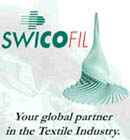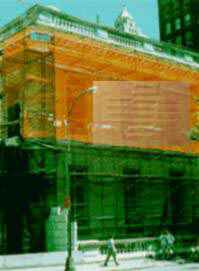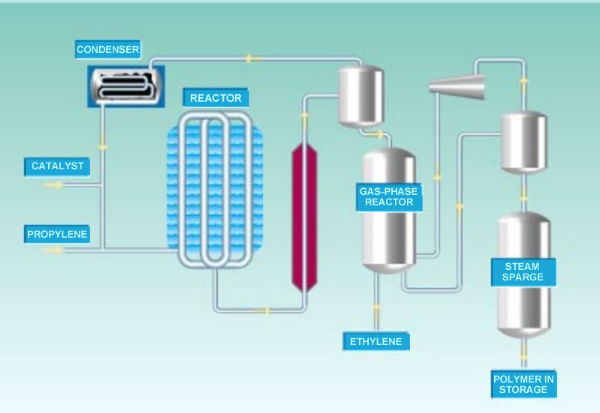|
|
||||||||
| Introduction The most important property of polypropylene is its versatility. It can be tailored to many fabrication methods and applications. Excellent chemical resistance, the lowest density, highest melting point (in the family of olefin fibers), and moderate cost makes it an important fiber in industrial applications. However, the poor dyeability and texturizability have limited polypropylene's applications in conventional textile industry. With the introduction of fiber denier textured yarn its use in apparel sector is becoming inevitable along with its main outlet in the industrial sector. When polypropylene was first introduced into the market in 1950s, the product is non-crystallizable, which result in low melting point. With the introduction of isotactic commercial polypropylene a considerable increase in the crystallinity and melting point was achieved. Polypropylene has registered continued worldwide market share growth in recent years and it is predicated that consumption will still grow as polypropylene increasingly are used as substitution for other materials such as glass, metal, and some engineering plastics
|
|||||||||||||||||||||||||||||||||||||||||
| Properties - fairly low physical properties - fairly low heat resistance - excellent chemical resistance - translucent to opaque - "living hinge" capability - low price - easy to process Heat setting removes the residual strains and produces a defect-free and stable crystalline structure to make fiber/fabrics dimensionally stable. It also improves the percentage of overall crystallinity. The smectic structure changes to more perfect monoclinic structure during the process of heat setting if the temperature is above 70oC . At 145oC the conversion is almost complete. In comparison to predominantly smectic form, the monoclinic form does not experience any major change in crystalline structure during the course of drawing and heat setting. Mechanical properties
The degree of orientation achieved by drawing influences the mechanical properties of PP filaments. The greater the degree of stretch, the higher the tensile strength and the lower the elongation. Commercial PP monofilaments have an elongation at break in the region of 12-25%. Multifilaments and staple fibers are in the range of 20-30% and 20-35%, respectively. Thermal properties
Dyeability Fiber modifications have been investigated to make polypropylene dyeable, which include copolymerization to provide dye sites along the macromolecular chain and blend with dyeable polymers. Baumann [7] reviewed the attempts by several researchers to improve polypropylene dyeability. The method of grafting chloromethylstyrene was introduced. In addition, the method of blending a polyethyleneimine compound with polypropylene was described briefly. Bromination of polypropylene fibers was reported to give PP fibers an affinity for basic dyes [8]. These methods leaded the significant decrease of the desirable physical properties of polypropylene fibers. In recent years, surface modification of hydrophobic fibers by plasma treatment opens up new possibilities in this field. Functional groups can be introduced onto the surface of PP fibers by special gas plasma treatment or plasma polymerization [9]. The polar layer on the fiber surface improves the wetability and the affinity of the fiber surface for water and water-soluble dye molecules. After reaction with the functional groups, which are introduced by plasma treatment, dye molecules are fixed on the fiber surface. Because plasmas do not interact with the inner part of the fiber, this technique may not greatly influence the mechanical properties of the treated fiber [10]. Great progress in improving dyeability of PP nonwoven webs had been made in Textiles and Nonwovens development Center (TANDEC), University of Tennessee at Knoxville. Other properties The main drawbacks of PP fibers are:
|
|||||||||||||||||||||||||||||||||||||||||
Applications
|
|||||||||||||||||||||||||||||||||||||||||
Grades
|
|||||||||||||||||||||||||||||||||||||||||
| Processability Processability of a polymer is highly dependent on its rheological properties, which have close relationship with its molecular weight, molecular weight distribution, temperature and shear rate. PP resins are generally categorized according to their melt flow rates ( MFR), which is the amount of material that comes through a standard die hole for ten minutes. Polymers with higher molecular weight have lower MFR and higher viscosity (under a given temperature). Commercial polypropylene has a wide range of MFR from 0.25 to 800. MFR is a very important parameter for both melt-blown and Spunbond processing. PP melts exhibit non-Newtonian viscosity, normal stress in shear flow, excessive entrance and exit pressure drop, die swell, melt fracture and draw resonance. PP melts are more visco elastic than PET and nylon melts. The flow pattern and stability of PP melts are highly dependent on the shear rate. Above the critical shear rate, melt fracture may occur. Processability of polypropylene fiber is also influenced by the dye geometry. The L/D ratio has to be optimized to reduce instability and the effects of PP's high viscosity. Both melt fracture and draw resonance represent instabilities in flow. Draw resonance is a periodic variation in diameter of a spinning threadline above a critical draw down ratio. Slowing down the drawing operation or a suitable cooling procedure may prevent this. In addition, processability of polypropylene fiber can also be affected by other factors such as finishing. Finish oil is a mixture of several chemicals that function as anti-static agent and lubricator to protect the filament. The results of the effects of finishing on this area are not available in this report yet. |
|||||||||||||||||||||||||||||||||||||||||
| Background
information Polypropylene is chemically very similar to polyethylene, consisting of only carbon and hydrogen atoms. One of its most important properties is its low price, which is due to a relatively simple synthesis from the low cost petrochemical, propylene. To be useful in a wider range of applications, polypropylene is often co polymerized with polyethylene, yielding a material with most of the temperature resistance, stiffness and strength of polypropylene, but better impact resistance contributed by the flexible polyethylene linkages. When polypropylene is listed in technical literature, "homopolymer" or "copolymer" is usually specified. Polypropylene is not as resistant to thermal or UV initiated degradation as polyethylene is. Even in stabilized grades it is not widely used in outdoor applications, except in black colors. (Carbon black acts as a good UV stabilizer) A very popular property of polypropylene is the "living hinge" effect. In thin sections where the molecules are oriented, the material can be flexed almost indefinitely without failure. Molecular orientation is crucial to this function and should be induced in the mold through the part design and gate location. Polypropylene is used widely in film, fiber, sheet, and molded applications. Most of the film is used in packaging. The fiber is used in carpeting and upholstery due to its wear and chemical resistance. Common molded applications include bottles, pipe, containers, and tanks, where the chemical resistance key. Due to its low cost, PP is used in toys, and disposable house wares. In summary, polypropylene is a versatile polymer, which through new technology is becoming more attractive to many markets including automotive and appliance, due to the low cost of the base polymer.
|
|||||||||||||||||||||||||||||||||||||||||
![]()
| Be notified of page updates |
wwwswicofilcom2015



